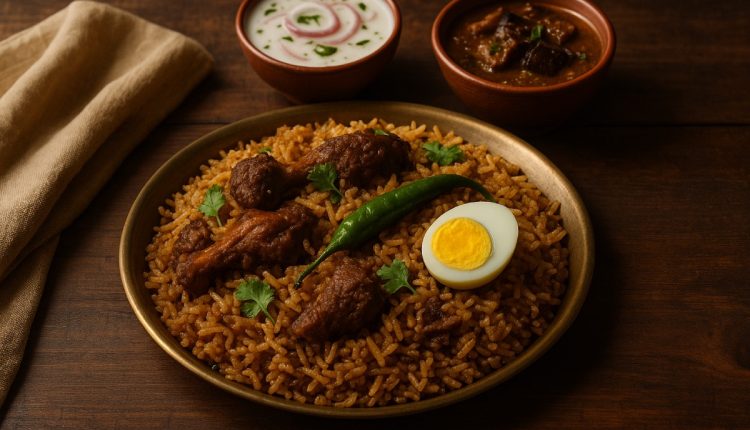When we think of biryani in Tamil Nadu, one name rises with unshaken loyalty—Dindigul Biryani. Famous across the state and beyond, this dish doesn’t just delight taste buds—it tells a story. A tale of strong spices, zesty flavors, and a town that turned a humble meal into an identity.
Let’s take a spicy journey into the origins, ingredients, and irresistible allure of Dindigul Biryani, a dish that’s tangy, meaty, and downright unforgettable.
Where It All Began: Dindigul, the Biryani Town
Located in the heart of Tamil Nadu, Dindigul is a city known for three things: its fort, its locks, and its biryani. The credit for popularizing this culinary marvel goes to Thalappakatti Naidu, who started serving his signature biryani in 1957 at a small eatery called Anandha Vilas Biryani Hotel.
What made it different? It wasn’t about fancy names or northern influence. It was a bold local innovation using seeraga samba rice, local masalas, and acidic notes from lemon juice and curd, giving it that trademark tang.
What Makes Dindigul Biryani Unique?
Unlike the long-grain basmati biryani you might be used to, Dindigul Biryani is all about short, aromatic seeraga samba rice, and a pungent, earthy spice mix. Here’s what sets it apart:
1. Seeraga Samba Rice
The star of the show—this tiny, fragrant rice absorbs the masala like a sponge. It doesn’t just carry flavor—it becomes flavor.
2. Meat Matters
The biryani is traditionally made with mutton, although chicken versions are also loved. The meat is marinated in curd, turmeric, and lemon, and cooked until tender and juicy.
3. Bold Spicing
Dindigul masala uses a blend of cloves, cinnamon, cardamom, kalpasi (black stone flower), star anise, and lots of black pepper. It’s spicy, yes—but layered and deep.
4. No Ghee Overload
Unlike other biryanis that go heavy on ghee or saffron, Dindigul biryani focuses on balanced spice and sourness rather than richness.
The Flavor Profile: Tangy, Spicy, Earthy
Take your first bite of Dindigul biryani, and here’s what unfolds:
-
The rice is aromatic with a hint of smokiness.
-
The meat is tender and falls apart, soaked in masala.
-
A slight tanginess hits next—lemon juice or curd making its presence known.
-
Then comes the heat, not overpowering, but a steady simmering spice that lingers.
It’s not a biryani that flatters. It fights for attention, and in doing so, becomes unforgettable.
What to Pair It With?
Like most Tamil Nadu biryanis, Dindigul biryani is served with:
-
Onion Raita – a simple yogurt and onion side that cools the spice
-
Brinjal Curry (Kathirikkai Pachadi) – spicy and tangy eggplant stew
-
Boiled Egg – always a welcome topper!
Popular Places to Try Authentic Dindigul Biryani
If you’re planning a culinary trip or ordering online, don’t miss these legends:
| Restaurant | Location | Must-Try |
|---|---|---|
| Thalappakatti Biryani | Across Tamil Nadu & India | Mutton Biryani |
| Ponram Biryani | Dindigul Town | Chicken Biryani with egg |
| Venu Biryani | Dindigul | Boneless Mutton Biryani |
| Anjappar | Chennai/Dindigul | Spicy Chicken Biryani |
Pro tip: Always ask for seeraga samba rice biryani if you’re eating outside Dindigul. Not every “Dindigul Biryani” on the menu sticks to tradition.
Want to Try Making It at Home?
Quick Ingredients List:
-
Seeraga samba rice – 2 cups
-
Mutton – 500g (bone-in preferred)
-
Curd – ½ cup
-
Lemon juice – 1 tbsp
-
Onions – 2, thinly sliced
-
Green chilies – 3
-
Tomato – 1, chopped
-
Ginger-garlic paste – 1 tbsp
-
Whole spices – cloves, cinnamon, bay leaf, star anise, cardamom
-
Mint & coriander – a handful
-
Oil – for cooking (no ghee!)
Cooking Steps (in brief):
-
Sauté whole spices in oil, then onions and green chilies until golden.
-
Add tomatoes, GG paste, then curd-marinated meat.
-
Cook till oil separates, then add soaked rice and water.
-
Cook on dum (low flame) until the rice is perfectly fluffy.
-
Serve hot with raita and brinjal curry.
Final Thoughts
Dindigul Biryani is not just a dish—it’s a statement of taste, tradition, and Tamil pride. In a world of saffron-drenched, ghee-laden biryanis, this one stands apart—tangy, gritty, spicy, and grounded in local culture.
So next time you crave biryani, skip the cliché. Go bold. Go Dindigul.


Comments are closed.